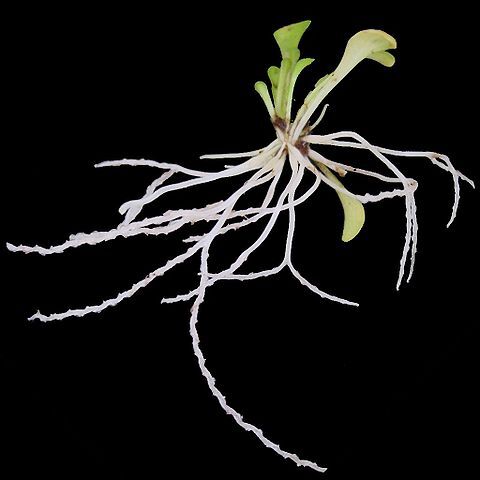Leaves dimorphic, persistent at anthesis; foliage leaves petioled, entire, linear-lanceolate to spathulate or circular, glabrous or rarely hairy, densely or laxly rosulate from the upper part of the stem; pitcher leaves (traps) more or less densely congested on the lower part of the stem and decending into the substrate and consisting of a stalk and a slender tube, cylindrical from an ellipsoid base and terminating in two ribbon-like helically twisted arms and tube provided internally with transverse rows of stiff inwardly directed hairs.
Inflorescence terminal and arising from the leaf-rosette, racemose, bracteate; peduncle simple or branched above, erect, usually glandular or hispid, rarely completely glabrous, provided with more or less numerous sterile bracts (scales); raceme congested to more or less elongated, few-many-flowered; pedicels usually considerably longer than the bracts, erect at anthesis, erect, spreading or strongly decurved in fruit, glandular, hispid or glabrous.
Corolla bilabiate, glandular, hispid or glabrous, blue, violet, mauve, yellow or white; superior lip more or less erect, entire or bilobed; inferior lip larger, spurred at the base; palate raised and more or less gibbous, limb spreading or deflexed, more or less deeply 3-lobed; spur acute or obtuse, shorter than to longer than the inferior lip.
Ovary globose, glandular, hispid or glabrous, style short, indistinct; stigma bilabiate; inferior lip about as broad as the ovary, semi-circular; superior lip more or less obsolete; ovules numerous, sessile on a fleshy free basal placenta, anatropous.
Capsule globose, valvate or uniquely multiple-circumscissile, the lower most line of dehiscence approximately equatorial and with two others between it and the persistent style.
Stamens 2, inserted at the base of the corolla; filaments falcate; anthers dorsifixed, ellipsoid, the thecae more or less confluent.
Calyx lobes 5, subequal, slightly accrescent, densely glandular to hispid or glabrous.
Calyx lobes 5, subequal, slightly accrescent, densely glandular to hispid or glabrous.
Bracts basifixed; bracteoles 2, inserted with the bract at the base of the pedicel.
Seeds exalbuminous, numerous, ovoid, reticulate, with a prominent hilum at one end.
Rootless perennial or annual herbs of wet places.
Stem short, subterranean, erect or decumbent.
